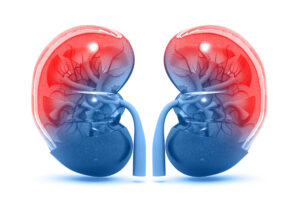December 7, 2023
Everyone has different tolerance levels to temperature. While some may be blistering in 72-degree weather, others may find it chilly, but if you’re always reaching for a sweater or blanket, you may have cold intolerance.
Cold intolerance can be a symptom of an underlying medical condition. The five most common reasons are:
- Anemia
- Peripheral artery disease
- Hypothyroidism
- Raynaud’s phenomenon
- Kidney disease
1. Anemia
Anemia is a common cause of constantly feeling cold, especially in your hands and feet. Anemia is a condition that develops when there is a lack of healthy red blood cells to carry adequate oxygen-rich blood to the body’s tissues.
What are the symptoms?
Feeling cold all the time isn’t the only symptom of anemia. Here are a few other common symptoms of the condition:
- Fatigue
- Headache
- Shortness of breath
- Pale or yellowish skin
- Irregular heartbeat
- Difficulty concentrating
- Brittle nails
 What are the causes?
What are the causes?
The primary cause of anemia is associated with a vitamin or mineral deficiency. However, with so many potential culprits, it can be hard to know what vitamin deficiency causes you to feel cold. Typically, it’s a lack of vitamin B12 or iron.
Iron deficiency can slow down thyroid function, which can lead to a condition called hypothyroidism, making you feel cold. Vitamin B12 deficiency results from your body not producing enough red blood cells needed to carry oxygen throughout the body.
What can you do?
If you think anemia could be the cause of always feeling cold, consult with a provider to obtain a blood test and check your iron and vitamin B12 levels. Your physician may suggest changing your diet to help improve vitamin and mineral levels.
Foods rich in vitamin B12 include eggs, fish, and chicken. If your anemia results from an iron deficiency, you can increase your intake of fish, pork, poultry, chickpeas, peas, soybeans, and dark leafy green vegetables.
2. Peripheral artery disease
Another condition that affects blood flow is peripheral artery disease (PAD). PAD develops when there is a build-up of fatty substances in your peripheral arteries, known as atherosclerosis. The peripheral arteries deliver blood from your heart throughout the rest of your body, particularly your lower extremities. When these arteries become clogged and narrowed, blood flow is reduced, and a lack of blood flow reduces the body’s temperature.
What are the symptoms?
Feeling cold is only one of many, some more concerning symptoms. Those that suffer from PAD may also experience:
- Poor toenail and leg hair growth
- Painful, sore leg muscles
- Numbness or heaviness in the legs when walking or climbing stairs
- Weak pulse in the legs or feet
- Pale, bluish skin
- Sores on the legs and feet that don’t heal
- Erectile dysfunction — typically associated with diabetes.
What are the causes?
The most common cause of peripheral artery disease is atherosclerosis. Still, some lesser-known causes of PAD include injury to legs or arms, radiation exposure, changes in the ligaments or muscles, and blood vessel inflammation.
There are a few factors that can increase your risk of developing PAD, like smoking, high cholesterol, high blood pressure, diabetes, obesity, increasing age, high levels of homocysteine, and a family history of PAD, heart disease, or stroke.
What can you do?
The first step is diagnosis, so contact a provider for testing. Your physician may recommend some lifestyle changes, medications, or surgery as treatment. A well-balanced diet and regular exercise can reduce your risk of build-up in the peripheral arteries.
Some common medications used to treat peripheral artery disease include antiplatelet medicines, statins, angiotensin II receptor blockers (ARBs), and ACE inhibitors. If diet, exercise, and medicine are not enough to treat PAD, your physician may recommend surgery to open up your peripheral arteries.
3. Hypothyroidism
Cold intolerance can point to a condition called hypothyroidism. Hypothyroidism develops when your thyroid gland does not produce enough hormones that regulate temperature and metabolism. Lack of thyroid hormones causes many of the body’s processes to slow down.
What are the symptoms?
In addition to always feeling cold, various other symptoms accompany hypothyroidism, including:
- Depression
- Constipation
- Menstrual issues
- Fatigue
- Thinning hair
- Low heart rate
- Weight gain
- Dry skin
What are the causes?
In the United States alone, roughly 4.6% of the population aged 12 and up have hypothyroidism. The most common cause of this condition is an autoimmune disease called Hashimoto’s disease, but it can also be due to Thyroiditis, radiation therapy, thyroid surgery, and certain medications. Some lesser-known causes are pregnancy, a pituitary disorder, birth issues, and an iodine deficiency.
The risk of developing hypothyroidism is higher if you are a woman, have an existing autoimmune disorder, received radiation of the upper chest and neck, had thyroid surgery, or have a family history of thyroid disease.
 What can you do?
What can you do?
A simple blood test can diagnose hypothyroidism, so reach out to your primary healthcare provider to schedule an appointment. There are various ways your physician may choose to treat hypothyroidism; though it can not be cured, it can only be controlled.
The treatment will focus on supplementing the thyroid hormone that is not being produced. Supplementation could include synthetic thyroxine, iodine, dietary changes, and more.
4. Raynaud’s phenomenon
Raynaud’s phenomenon, syndrome, or disease can cause cold intolerance due to a temporary narrowing of the blood vessels, which decreases blood flow to the body. It primarily affects the fingers and toes, but symptoms of Raynaud’s can also be experienced in the ears, lips, nose, and nipples. Typically, Raynaud’s occurs when temperatures drop and the blood vessels spasm and constrict.
There are two types of Raynaud’s: primary and secondary. Primary Raynaud’s is more common and tends to affect those with no secondary medical condition, whereas secondary Raynaud’s results from an underlying medical condition.
What are the symptoms?
The most common symptom of Raynaud’s is coldness in the toes and fingers, but there are accompanying symptoms that will let you know if it’s Raynaud’s, including:
- Tingling sensation
- Affected area turns white, then blue
- Swelling
- Painful throbbing
- Red flush once blood flow returns to the affected area
These symptoms can be experienced in the fingers, toes, lips, nose, ears, and nipples.
What are the causes?
The exact cause of Raynaud’s disease is still unclear; however, hyperactivation of the sympathetic nervous system, known as vasoconstriction, affects the body similarly, causing an extreme narrowing of the blood vessels. Those with Raynaud’s are often affected when they come in contact with cold temperatures in any capacity. In some cases, it has been known to occur without a temperature drop due to stress.
Secondary Raynaud’s is associated with an underlying medical condition. Causes of secondary Raynaud’s include diseases of the connective tissue, diseases of the arteries, carpal tunnel syndrome, injuries, repetition or vibration, exposure to certain substances, and certain medications.
What can you do?
Unfortunately, Raynaud’s has no cure, but it can be treated and managed. Treatments can be as simple as properly covering exposed skin or soaking the affected area in warm water for mild cases.
Moderate to extreme cases of Raynaud’s can be treated with the proper medication, including vasodilators, dihydropyridine calcium channel blockers, Alpha-1 blockers, and topical nitroglycerin ointment. Depending on the severity of the disease, your physician could also recommend nerve surgery or chemical injections.
 5. Kidney disease
5. Kidney disease
Medical conditions like high blood pressure or diabetes can lead to kidney disease, affecting your body’s ability to regulate temperature. Kidney disease is when your kidneys don’t filter your blood properly, leading to waste build-up, which can lower your body’s core temperature.
What are the symptoms?
The symptoms of kidney disease develop as kidney damage progresses, so not all symptoms may be experienced right away; some may develop with time. In addition to cold intolerance, symptoms of kidney disease can include:
- Fatigue
- Weakness
- Sleep issues
- Decrease of mental clarity
- Loss of appetite
- Nausea
- Vomiting
- Muscle cramps
- Swelling of ankles and feet
- Shortness of breath
What are the causes?
Kidney disease develops when an underlying condition or disease impairs the function of the kidneys, causing damage over time. Those diseases and conditions can include high blood pressure, polycystic kidney disease, enlarged prostate, kidney stones, interstitial nephritis, glomerulonephritis, type 1 or type 2 diabetes, kidney infection, vesicoureteral, and some cancers.
What can you do?
Early detection can prevent kidney disease from progressing to kidney failure, so contact your primary healthcare provider if you suspect any issue with your kidneys. If you have any underlying medical condition affecting your kidneys, your physician can work with you to reduce the risk of developing kidney disease.
The risk of kidney disease increases with factors like smoking, misuse of over-the-counter medication, heart disease, obesity, aging, certain races or ethnicities, abnormal structure of the kidneys, and family history of kidney disease.
When to seek a provider
While it’s important to recognize your symptoms, diagnosis of any condition should be done by a professional provider. Healthcare Associates of Texas has been helping their patients in the Dallas/Fort Worth community for 25 years. If you have any medical concerns associated with cold intolerance, their expert staff can be there to guide and treat you.
References
- Crain, E. (2023, August 25). Why Am I Always Cold? 11 Reasons Why You Can’t Stop Shivering. Health. https://www.health.com/mind-body/why-am-i-always-cold#:~:text=Some%20people%20may%20feel%20colder
- Hayes, K. (2018, February 23). 5 Reasons You’re Always Cold. AARP. https://www.aarp.org/health/conditions-treatments/info-2018/reasons-for-being-cold-fd.html#:~:text=Lack%20of%20vitamin%20B12%20and
- Kumar, MBBS, K. (2021, November 10). What Does It Mean When You Are Always Cold? Vitamin Deficiency, Diet (P. S. Uttekar, MD, Ed.). MedicineNet. https://www.medicinenet.com/what_does_it_mean_when_you_are_always_cold/article.htm
- Mayo Clinic. (2021). Chronic kidney disease – Symptoms and causes. Mayo Clinic. https://www.mayoclinic.org/diseases-conditions/chronic-kidney-disease/symptoms-causes/syc-20354521
- Mayo Clinic. (2022a, June 21). Peripheral artery disease (PAD) – symptoms and causes. Mayo Clinic. https://www.mayoclinic.org/diseases-conditions/peripheral-artery-disease/symptoms-causes/syc-20350557
- Mayo Clinic. (2022b, December 10). Hypothyroidism (underactive thyroid). Mayo Clinic. https://www.mayoclinic.org/diseases-conditions/hypothyroidism/symptoms-causes/syc-20350284
- Newman, T., & Sampson D.O., S. (2017, December 19). Raynaud’s disease: Treatment, causes, and symptoms. Www.medicalnewstoday.com. https://www.medicalnewstoday.com/articles/176713#treatment
DISCLAIMER
The information featured in this site is general in nature. The site provides health information designed to complement your personal health management. It does not provide medical advice or health services and is not meant to replace professional advice or imply coverage of specific clinical services or products. The inclusion of links to other web sites does not imply any endorsement of the material on such websites.